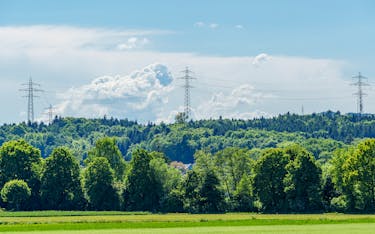Digitisation Innovation Swissgrid

In the spring, nature comes to life. Trees bear leaves and blossoms again, bringing joy with their colourful splendour. But more than that, they grow upwards towards the sky. What happens if a tree is growing towards a high-voltage power line? How does Swissgrid identify trees that are getting too close to a line? With 12,000 pylons and 6,700 km of lines, finding these critical trees is no easy task. In the past, the distance of each tree in relation to the line was checked visually during the annual line inspection. The analyses from these visual checks were often inaccurate, representing merely a snapshot of the time when the measurement was taken. However, the sag in the line depends on the temperature, the wind and the load the line is carrying.
Today, laser scanning data helps to determine the precise distance between the line and each tree. Helicopters fly over Swissgrid’s power lines every two years for this purpose. They use a laser scanner to capture the line and its surroundings in 3D point clouds. 3D models are used to calculate the distance of each tree, taking different scenarios into account (for example a full load on the line in the summer or wind deflection). This process also identifies trees that could fall onto the line. Throughout Swissgrid’s entire grid, priority is automatically given to the trees that must be felled first. The results are enhanced with additional attributes (e.g. affected plots) in a geographical information system and made available to Swissgrid’s foresters for processing.
Six foresters are continually on duty
Swissgrid’s six foresters plan and carry out logging work along the power lines on the basis of these analyses. This way, the lines can be operated safely at all times and outages are avoided. The foresters thus also help to ensure biodiversity in the vicinity of the lines, because power line routes create habitats for numerous plants and animals. The vegetation management carried out by the foresters is therefore not only important for security of supply and line maintenance, but also creates ecological added value.




